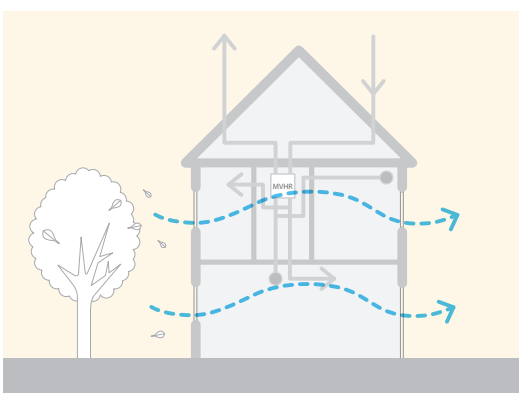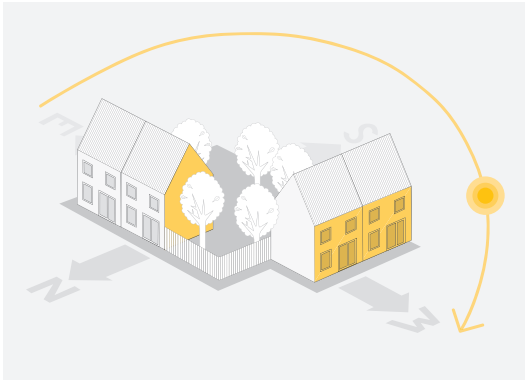Nowadays planners, designers and property owners has to face
new difficulties. Appears to be growing evidence of overheating in homes, as
the new houses satisfy more demanding standards of energy efficiency.
Additionally, climate change leads to global temperature rise which affects
home temperature as well. Overheating can cause a discomfort or sometimes over
longer periods can be harmful to occupants, in extreme cases even put there
life at risk. People who are more likely to be occupying their homes during the
hottest periods at the day (daytime), are most vulnerable to overheating, such
as the elderly or sick.
Overheating – it is conditions in building, when the warmth cause
discomfort and heat stress to occupants. After some tests was found out that
most people begin to feel ‘warm’ at 25C and ‘hot’ at 28C, above internal
temperature of 35C there is a significant danger of heat stress.
External gains
 Sunlight through the windows heats the interior surfaces.
This heat remains trapped inside the building. It works the same as greenhouse,
thus sometimes the process is called ‘greenhouse effect’. On the new built
dwellings the ‘greenhouse effect’ is even bigger. Modern houses with double or triple
glazed windows and high insulation will tend to retain the heat indoors and
allow it to build up. On winter time it will help to keep the warmth inside the
building, however, on summer period it can cause overheating.
Sunlight through the windows heats the interior surfaces.
This heat remains trapped inside the building. It works the same as greenhouse,
thus sometimes the process is called ‘greenhouse effect’. On the new built
dwellings the ‘greenhouse effect’ is even bigger. Modern houses with double or triple
glazed windows and high insulation will tend to retain the heat indoors and
allow it to build up. On winter time it will help to keep the warmth inside the
building, however, on summer period it can cause overheating.
Inside the well-insulated and poorly ventilated houses
internal heat gains can have serious consequences. There are 4 types of
internal gains:
Occupants and their activities – people inside the house
emit the heat in form of ‘metabolic’ gains. More people move, more energy (in
form of heat) they radiate into the environment. Also, all the activities like
cooking, bathing, showering contribute to heat gains.
Appliances – fridges, washing machines, TV’s, computers,
microwaves etc emits heat even in standby mode.
Building services – mechanical ventilation system, hot water
distribution and storage systems poorly insulated can have a massive impact on
heat emission inside the building.
Lightening – even low energy lights can add heat gains.
Other factors which might increase overheating
Site context – if house is surrounded by noisy objects like
busy roads, industrial buildings, railways etc it may prevent occupants from
opening the windows enough for ventilation. Also, the temperature is always
higher in cities to compare with the rural environment.
Orientation – it makes a significant impact on solar gains. Houses
with large amount of west-facing windows will gain more heat than the ones
facing north.
Building designs – Modern houses are high insulated, which
means that the heat gains are retained inside and needs to be removed actively seeking
to avoid overheating.
Ways to reduce the overheating
There are many ways to reduce the overheating such as:
Orientation – intentionally selected orientation can help to
control solar heat gains.
Shading – It is effective way to reduce the sun heat gains
only by using curtains, blinds, shutters. Also fencing and planting could work
as valuable shades for the house.
 |
| Purge ventilation |
Cooling ventilation strategies – homes with the installed
ventilation systems (including purge ventilation) helps to release heat from
the inside the building. However, occupants should have great knowledge how to
use it, to avoid heat loss.
Heat reflective finishes – light colour finishes, reflective
or green/brown roof has a huge impact on keeping temperatures down.
Appliances – trying to use energy efficiency appliances at
home, do not keep them turned on when not using etc
Lighting – use low energy light bulbs, do not keep lights on
when not in use.
Case study
 Again for the case study I will use Greenwatt Way development. As I have already mentioned on my previous posts all the houses on this development are well-insulated and heat loss parameters achieved requirements of Code for sustainable homes level 6 (0.8W/m2K). However, such a low heat loss might cause overheating problems, especially on summer time. Thus, it is essential to find some ways to get rid of warmth inside. For this, the high level rooflight was installed to ensure a good purge ventilation. Moreover, high performance triple glazed windows with draught resistant seals allow larger openings fore natural ventilation. Finally, whole house ventilation with heat recovery, which allows fresh, pre-heated air get into all living areas and bedrooms.
Again for the case study I will use Greenwatt Way development. As I have already mentioned on my previous posts all the houses on this development are well-insulated and heat loss parameters achieved requirements of Code for sustainable homes level 6 (0.8W/m2K). However, such a low heat loss might cause overheating problems, especially on summer time. Thus, it is essential to find some ways to get rid of warmth inside. For this, the high level rooflight was installed to ensure a good purge ventilation. Moreover, high performance triple glazed windows with draught resistant seals allow larger openings fore natural ventilation. Finally, whole house ventilation with heat recovery, which allows fresh, pre-heated air get into all living areas and bedrooms.References:
'Greenwatt way' [Online]
Availabe at: http://www.thisisconcrete.co.uk/home_page/case_studies/greenwatt_way.aspx
[Accessed at 15th of November, 2013]
‘Greenwatt Way. A zero carbon homes newbuild case study’,
2011. Energy saving trust.
Historic Scotland Alba
Aosmhor. ‘Fabric improvements for energy efficiency in traditional buildings’ [Online] Availabe at: http://www.historic-scotland.gov.uk/fabric_improvements.pdf
[Accessed at 15th of November, 2013]
‘Greenwatt way’ [Online] Available at: http://www.house-builder.co.uk/documents/WILFORD-Chris.pdf
[Accessed at 15th of November, 2013]
‘Fabric first’, October
edition, 2010. Energy saving trust
Richards Partington Architects,
2012. ‘Understanding overheating – where to start’ NHBC Foundation
Grater London Authority, 2008. ‘Your home is in a changing
climate’ [Online] Available at: http://www.ukcip.org.uk/wordpress/wp-content/PDFs/3Regions_Retrofitting.pdf
[Accessed at 16th of November, 2013]
Zero Carbon Hub, ‘Overheating in homes’ [Online] Available
at: http://www.zerocarbonhub.org/resourcefiles/OverheatingInHomes8pp_2013_8March.pdf
[Accessed at 16th of November, 2013]



No comments:
Post a Comment